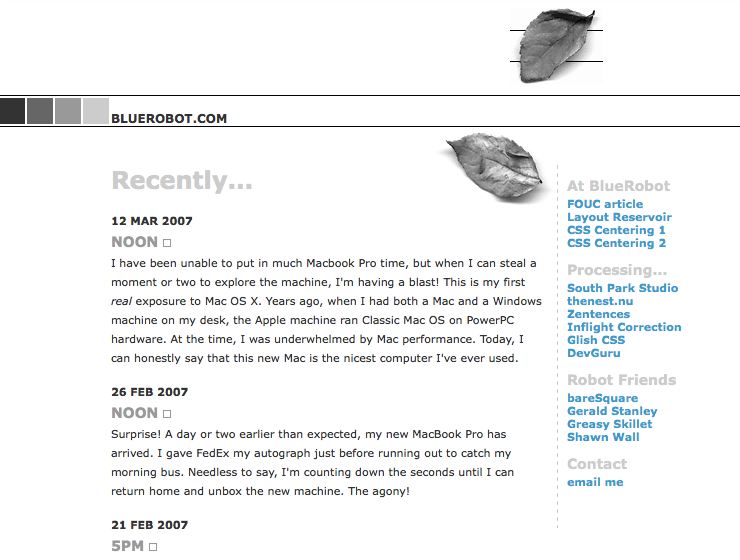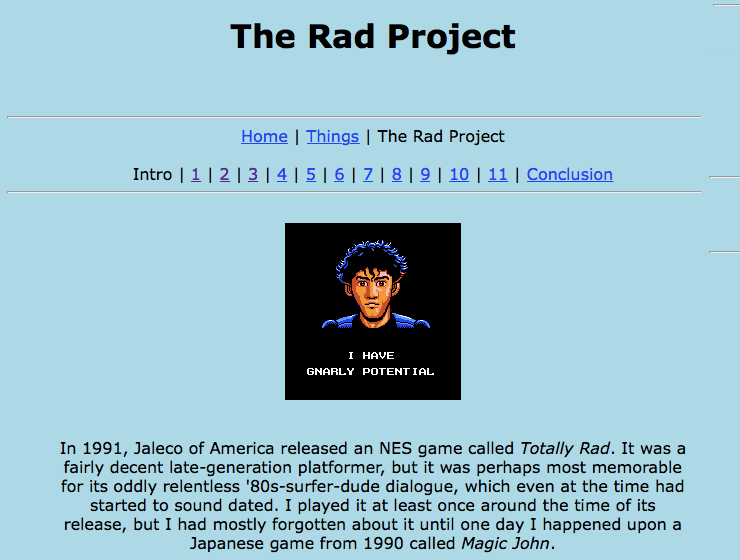Over the last few months, I’ve been doing a little bit of internet archaeology. Whether it’s pointing out dodgy updates to sites about murder, tracing what happened to Twitter favourites aggregator Favrd, figuring out what the deal is with an extremely weird abandoned website, or looking at good archivists and bad archivists, all of these investigations relied on one thing: the Wayback Machine from the Internet Archive, taking us back in time to examine websites at a different point in their existence. Or in some cases, to websites which have disappeared entirely. (Don’t forget my plea to think about giving the Internet Archive a donation.)
Today I want to use the Wayback Machine to talk about a couple of sites which meant a lot to me, but which are no longer online in their original form. One is more serious, and the other is a ridiculous amount of fun. Both of them, in one way or another, changed the way I think about things.
BlueRobot
 Original URL: bluerobot.com (Now a site about some kind of automated Twitter product, which is nothing to do with the original site)
Original URL: bluerobot.com (Now a site about some kind of automated Twitter product, which is nothing to do with the original site)
Archive URL: Wayback machine
Years online: 2001-15
I spent two years at university, back in 2001-03. The first year I spent failing a BSc in Computer Science. The second year I spent failing an HND in Software Development. I also spent a lot of time skulking in my room eating KFC, and failing to wash.
Needless to say, it was not the best period in my life.
I did, however, get one thing out of it. (Well, two things, but a detailed analysis of my sex life is required by precisely no-one.) Instead of going to lessons, I spent a lot of time in the university library, messing around on the internet extensively for the first time in my life. And – in the one thing I actually got from my failed degree – that first year prodded me into learning how to write and design web pages. I took to it immediately, learnt far more than the module required… and yet still didn’t manage to do the coursework required to pass. Because I was a dickhead.
Sadly, one thing my course didn’t seem very keen on web standards or accessibility – and I found myself devouring every site I could find which talked about them. One site which was particularly important in those days was BlueRobot – and specifically, the section titled The Layout Reservoir. Web standards… but practical techniques which you could actually use to make nice-looking sites, even back in those days of ultra-shitty-and-incompatible-browsers. I learnt so much CSS from that site, which I used and adapted on my own early projects. I can’t over-emphasise how much I learnt simply from examining the sample markup on that site and picking it apart, and the same is true of so many other people. It’s never really talked about now, but back then the site – and those techniques – were famous in web circles.
BlueRobot stopped updating in 2007 (without saying goodbye), but remained online until 2015… when some tech company with a stupid Twitter product bought the domain, wiping out a huge piece of web history. As for Rob Chandanais, who ran the site, he seems to have disappeared. He had a Flickr account, which last showed activity at the start of 2014. Aside from that, he seems to have fallen off the public web.
Strange for someone who was so influential in those early days of web standards and CSS.
The Rad Project
 Original URL: http://www.flammie.net/vse/things/rad/
Original URL: http://www.flammie.net/vse/things/rad/
Archive URL: Wayback machine
Years online: 2003-14
This is a personal love of mine. I linked to it on Twitter. I linked to it on Twitter again. I linked to it on Twitter for a third time. I posted it to Tumblr. I never had any response. So I tried to have a conversation with an actual person about it, to which the reply was: “I don’t understand it”. Screw you guys. It’s still one of my favourite pieces of writing in the world.
The best I can do is point you towards the intro:
“In 1991, Jaleco of America released an NES game called Totally Rad. It was a fairly decent late-generation platformer, but it was perhaps most memorable for its oddly relentless ’80s-surfer-dude dialogue, which even at the time had started to sound dated. I played it at least once around the time of its release, but I had mostly forgotten about it until one day I happened upon a Japanese game from 1990 called Magic John.
It was Totally Rad. And yet it was not.
As I glanced through Magic John‘s cutscenes, I quickly noticed that the original game had in fact been played completely straight. The bodacious ‘tude and happenin’ sensibility of Totally Rad had been solely an invention of its localization team at Jaleco, who not only played fast and loose with their translation but also entirely redrew two of the characters. While the story of the original is merely dorky and forgettable, the American release crosses the line into a glorious retroverse that renders it an oddly prescient ironic masterpiece.
Once I realized how much had been changed, I knew that I would eventually need to make an in-depth study of the localization to document the changes. Thus was born The Rad Project.”
The whole thing is worth reading in full. It’s in turn hilarious, enlightening, and just plain one of the most fun things I’ve ever read. To describe any more would ruin it. Dive in.
Still, why is the piece so important to me, aside from the sheer fun factor? Partly because it was the first time I really learnt about the subject of translation versus localisation. This is a subject covered at length on sites like Legends of Localization, but this was my very first experience of it. It blew my mind – just like BlueRobot, it opened me up to a world I’d never really known about before. One of the running threads through my interests is things which are the same, but not: it’s the same part of me that writes about edits made to Hi-de-Hi!, or alterations made to the The Quatermass Experiment. People’s intentions when they change something – in a film, a TV programme, a videogame, or whatever – fascinate me in places deeply buried in my skull.
The “Video Smash Excellent” site went online in 2002; the section on Totally Rad was originally published in 2003. The site stopped updating in 2006 (with no warning), so perhaps it’s incredible it managed to survive right through to the beginning of 2014; flammie.net is now a GoDaddy holding page. And so another beautiful piece of writing and research bites the dust… unless you know where to look.
And knowing where to look is the real thing here. It’s all very well the Wayback Machine giving us access to all this wonderful stuff – but unless you know what to look for, it’s just a collection of stuff sitting on a server nobody will ever see again.
What I’d love to do is throw it open. Which sites meant something to you, have now disappeared, but you can relive through the Wayback Machine? Comment below, tweet me, or even write a blog post about it and send me the link. It can be a huge, well-known site… or the tiniest of tiny blogs. Anything which had a huge effect on you at the time, but which has now fallen to the linkrot bogeyman.
Even if this stuff survives, without people talking about it, it’s next to useless. Let’s take a moment to sit back… and remember.

One comment
Darrell on 4 December 2016 @ 7pm
Neilinnes.org – launched in the late 1990s, and was a huge part of my life from about 1998-2003. It made me a huge fan of someone whose work became very important to me, made me lasting friends of other fans, plus the lyrics/chords on there made me a much better pianist and singer. I became friends with its main webmaster Bonnie Rose and ended up contributing the odd bit here and there. She carried on adding increasingly wonderful and elaborate microsites to it as time went on but sadly died at the beginning of last year, soon after which it expired and fell offline (after being a permanent fixture for the best part of two decades). Still miss knowing Bonnie and still miss the site. More or less all there on archive.org but with enough holes to be upsetting.
Comments on this post are now closed.